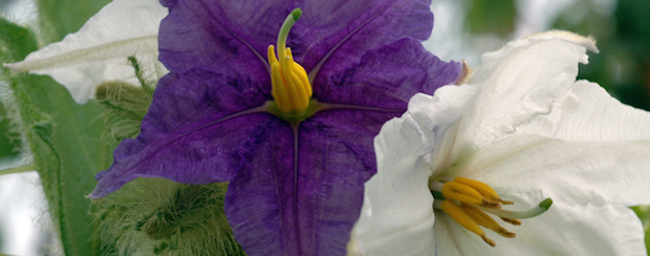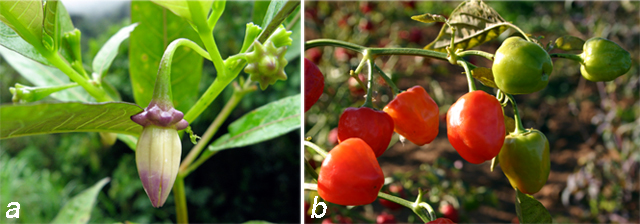
Projects
Solanum: A Worldwide Treatment
Overall Solanum Phylogeny
Phylogeny and Systematics of Solanum clades
Character Evolution in the Solanaceae
Systematics and Phylogeny of Capsicum and Lycianthes
Solanum: A Worldwide Treatment
This project, funded by the NSF Planetary Biodiversity Inventory (PBI) program, aims to complete a taxonomic monograph of the entire genus Solanum. This collaborative project involves four Solanaceae specialists as co-PIs and other collaborators from throughout the world who contribute taxonomic treatments and related data. All information from this project is electronically archived and disseminated on our website, the Solanaceae Source. The results of this project are not only documenting biodiversity in one of the largest and most diverse genera of flowering plants, but also link up-to-date taxonomic information about wild species of Solanum with genomic information about the agronomically important species of the genus (potato, tomato, and eggplant). Ultimately, each accepted Solanum species will have a separate page on our website, which includes information on nomenclature, morphology, phylogeny, distribution, phenology, breeding systems, and phylogeny. Our database includes tens of thousands of collection records databased from herbarium specimens; georeferenced collections are dynamically mapped on our website. Images of living plants and herbarium specimens, including types, are displayed on the species pages. Molecular information from GenBank is searched on the fly to provide a “one-stop shop” for all relevant information about each Solanum species.
Check out these sample species pages on our Solanaceae Source website: Solanum aphyodendron, S. bulbocastanum, or S. lycopersicum.
Representative publications based on this project:
Knapp, S., Bohs, L., Nee, M., and D. M. Spooner. 2004. Solanaceae – a model for linking genomics with biodiversity. Comparative and Functional Genomics 5: 285-291. PDF
Nee, M., L. Bohs, and S. Knapp. 2006. New species of Solanum and Capsicum (Solanaceae) from Bolivia, with clarification of nomenclature in some Bolivian Solanum. Brittonia 58: 322-356. PDF

A species of Solanum sect. Geminata from Peru.
Back to top
Overall Solanum Phylogeny
Several projects have focused on phylogenetic relationships in the entire genus Solanum and in some of its component clades. Solanum, with approximately 1500 species, is one of the largest genera of flowering plants. As such, its taxonomy has been complicated and systematists have avoided work on it. This is despite the fact that it includes some of our most important crop species such as potato (S. tuberosum), tomato (S. lycopersicum), and eggplant (S. melongena). Previous Solanum systematists recognized seven subgenera within Solanum, ranging in size from subgenus Lyciosolanum that includes just one species to subgenus Leptostemonum that includes hundreds of species. An overall phylogeny of Solanum using molecular data from three nuclear and chloroplast genes shows that few of these subgenera comprise monophyletic groups; instead, Solanum consists of about 12 to 15 major clades. These have been given informal names and are themselves the subjects of more detailed phylogenetic studies.
Relevant publications:
Bohs, L. 2005. Major clades in Solanum based on ndhF sequence data. Pages 27-49 in R. C. Keating, V. C. Hollowell, and T. B. Croat (eds.), A festschrift for William G. D’Arcy: the legacy of a taxonomist. Monographs in Systematic Botany from the Missouri Botanical Garden, Vol. 104. Missouri Botanical Garden Press, St. Louis, MO. PDF
Weese, T. L. and L. Bohs. 2007. A three gene phylogeny of the genus Solanum (Solanaceae). Systematic Botany 32: 445-463. PDF

Examples from Solanum: (a) S. unilobum from the Cyphomandra clade is a wild relative of the tree tomato; (b) S. quitoense, the "lulo" or "naranjilla" is cultivated for its fruits which are used to make a tangy, refreshing juice; (c) S. thelopodium, an unusual Amazonian species that seems to be sister to all other Solanum species; (d) S. incanum, a wild relative of the cultivated eggplant;(e) S. chilense,a wild relative of tomato showing the sterile anther tips characteristic of tomato and its relatives.
Phylogeny and Systematics of Solanum clades
We hope to generate phylogenies and molecular information for as many species and clades of Solanum as possible. One focus has been on the Leptostemonum clade, or subgenus Leptostemonum, which is the largest clade in Solanum with ca. 350-450 species. This group is called the “spiny solanums” because most species bear prickles in addition to stellate hairs. The Leptostemonum clade is interesting biogeographically because it occurs on all temperate and tropical continents. Completed work includes an overall phylogeny for the Leptostemonum clade based on nuclear and chloroplast sequence data. Well-supported clades have been given informal names, as in the work on Solanum as a whole. One major finding is that the vast majority of the Old World spiny solanums belong to a single clade. Work is in progress on this Old World clade to determine its fine-scale phylogenetic relationships and to examine evolution in the eggplant and its relatives, members of the Old World clade.
Relevant publications:
Bohs, L. 2004. A chloroplast DNA phylogeny of Solanum section Lasiocarpa (Solanaceae). Systematic Botany 29: 177-187. PDF
Levin, R. A., K. Watson, and L. Bohs. 2005. A four gene study of evolutionary relationships in Solanum section Acanthophora. American Journal of Botany 92: 603-612. PDF
Levin, R. A., N. R. Myers, and L. Bohs. 2006. Phylogenetic relationships among the “spiny solanums” (Solanum subgenus Leptostemonum, Solanaceae). American Journal of Botany 93: 157-169. PDF
Anderson, G. J., G. Bernardello, L. Bohs, T. Weese, and A. Santos-Guerra. 2006. Phylogeny and biogeography of the Canarian Solanum vespertilio and S. lidii (Solanaceae). Anales del Jardín Botánico de Madrid 63: 159-167. PDF

The spiny solanums (subgenus Leptostemonum): (a) Solanum sisymbriifolium fruits; (b) sect. Crinitum, spines and stellate hairs that characterize subgenus Leptostemonum; (c) sect. Lasiocarpa, flower. See Bohs 2004 and Levin et al. 2005, 2006 above for more on subgenus Leptostemonum.
See our Cyphomandra poster from the BSA/ASPT meeting in Savannah, GA
.Back to top
Character Evolution in Solanaceae
The availability of phylogenies for groups within the Solanaceae enables character patterns to be examined in an evolutionary framework. The incredible variation in morphological, chemical, and reproductive characters exhibited in this family makes it ideal for elucidating the evolution of traits such as floral zygomorphy, fruit morphology and chemisty, and self-incompatibility systems. Collaborations with ecologists and evolutionary biologists have been productive in using the Solanaceae as model systems to study evolutionary patterns in important characters such as these, and insights gained from the Solanaceae may be applicable to the evolution of similar characters in other groups of flowering plants. The Bohs lab welcomes collaborations with biologists interested in using the Solanaceae to examine evolutionary questions.
Relevant publications:
Cipollini, M. L., L. A. Bohs, K. Mink, E. Paulk, and K. Böhning-Gaese. 2002. Patterns of secondary compounds within fleshy fruits: ecology and phylogeny. Pages 111-128 in D. J. Levey, W. R. Silva, and M. Galetti (eds.), Seed dispersal and frugivory: ecology, evolution and conservation. CABI Publishing, Wallingford, Oxfordshire, UK. LINK
Igic B., L. Bohs, and J. R. Kohn. 2003. Historical inferences from the
self-incompatibility locus. New Phytologist 161: 97-105. PDFIgic B., L. Bohs, and J. R. Kohn. 2006. Ancient polymorphism reveals unidirectional breeding system shifts. Proceedings of the National Academy of Sciences 103:1359-1363. PDF
Bohs, L., T. Weese, N. Myers, V. Lefgren, N. Thomas, A. Van Wagenen, and S. Stern. 2007. Zygomorphy and heterandry in Solanum in a phylogenetic context. Acta Horticulturae 745: 201-223. PDF

Examples of heterantherous species of Solanum. From left to right: S. crinitum, S. rostratum, S. trisectum, S. sisymbriifolium, S. citrullifolium. See Bohs et al. 2007 above for more information.
Systematics and Phylogeny of Capsicum and Lycianthes
Chili peppers, in the genus Capsicum, are among the most charismatic members of the Solanaceae. The genus includes some 25 to 30 New World species with five domesticated species. Although Capsicum peppers are well-known ingredients in cuisines worldwide, its sister genus, Lycianthes, has been very poorly studied. Lycianthes, with about 200 species, is much larger than Capsicum and has a worldwide distribution. Family-wide phylogenies of the Solanaceae have established the close relationship between Capsicum and Lycianthes, but the more detailed picture of their species-level relationships has not been known. Ongoing studies in the Bohs lab are focusing on these two genera in order to examine their monophyly, their relationship to each other, the relationships of the domesticated Capsicum species to their wild relatives, and the evolution of pungency within Capsicum. In addition to providing a phylogeny for the Capsicum/Lycianthes clade, we are examining evolutionary patterns in the Pun1 locus that determines pungency. Collaborations with the Jahn lab at Cornell and with Ellen Dean at UC-Davis are elucidating Pun1 gene expression and Lycianthes taxonomy, respectively, and will increase our understanding of the chili peppers and their neglected sister group, Lycianthes.
We have sequenced the transcriptomes of four species of Lycianthes and Capsicum, and have found significant discordance among gene trees from 5000 loci. See our transcriptome research here and our new phylogeny of Capsiceae here.

(a) Lycianthes sp. showing the 10 submarginal teeth on the calyx that
characterize the genus;
(b) Fruits of Capsicum sp.
See our poster from the BSA/ASPT meeting at Snowbird, UT

